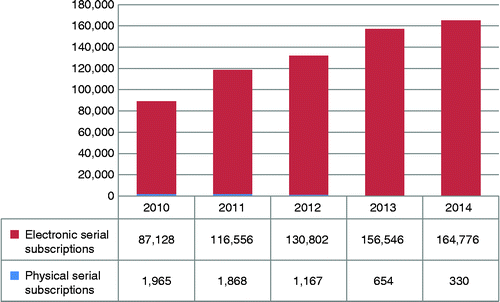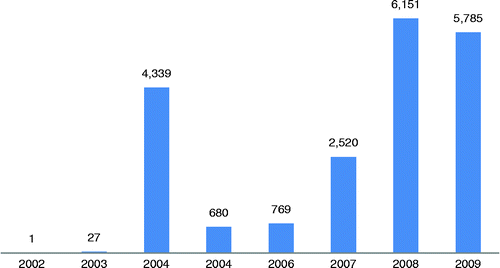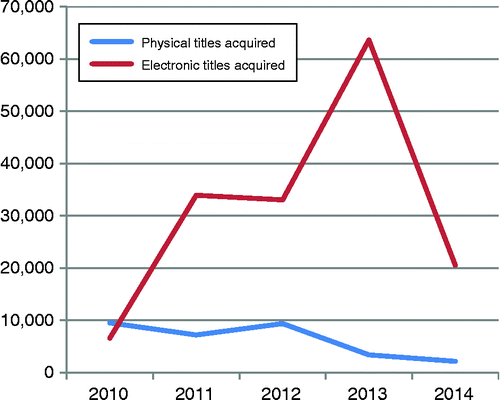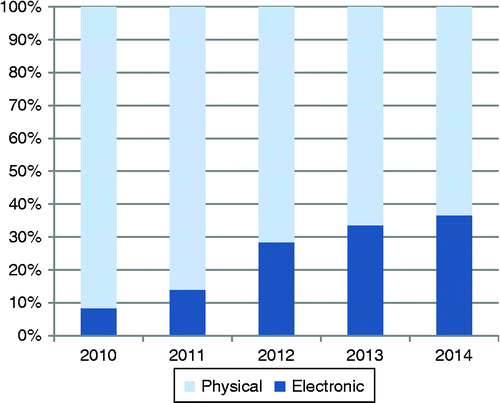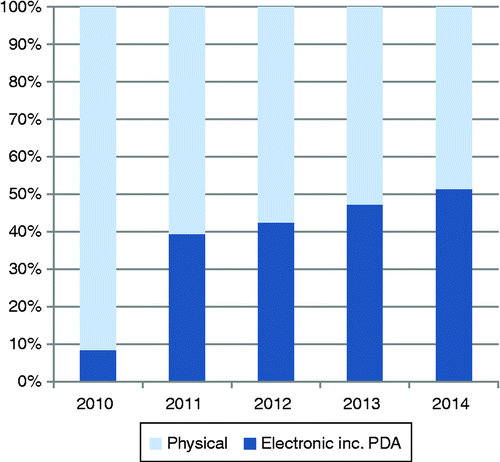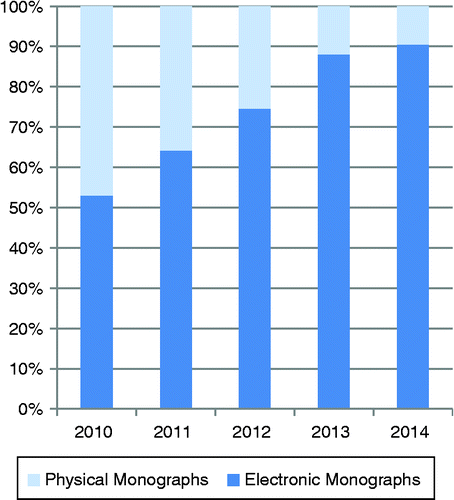Abstract
This article tests ALIA's statement that ‘library print and ebook collections will establish a 50:50 equilibrium by 2020’ against the experience and likely trajectory of Curtin University Library. It identifies features of the higher education landscape that have led to the development of epreferred strategies, outlines current collection principles, and describes the current state of the Library's holdings. Looking ahead, the article charts the likely impact of the current collection development framework over the next six years, considering questions relating to budget, use of space, client experience and treatment of the legacy print collection.
Implications for best practice
Numbers of ebooks available in many academic libraries will exceed numbers of print books in the near future.
Changes in teaching and learning in higher education will maintain the requirement for flexible access to information resources, and building on electronic collections will be fundamental for libraries in the future.
Ebook growth in library collections will be highly affected by budgetary circumstances, and careful financial planning will be required.
As the number of ebook purchases continues to increase, a strategy to deal with the legacy print collection will need to be put in place.
Introduction
There are many reasons why acquiring information resources in electronic formats has been an attractive proposition for university libraries. Fundamental is the realisation that the electronic online environment enables libraries to provide a much richer set of resources to a much wider audience, and to remove the barriers of space and time which applied to traditional, print-based collections. The work of universities in promoting teaching, learning and research is thus made more efficient, and the potential reach of any individual university is vastly increased – and this is particularly important in the context of increasing national and global competition for students and for funding.
The trajectory of digitisation has proceeded at different rates for different types of information resource. The publishers of indexes and other types of reference work which required constant updating were among the first to see the benefits of online distribution of content, even before the invention of the world wide web in the mid-1990s. Academic journal publishers began to follow shortly after, and while print copies of journals continue to be produced, it is now the electronic versions which are overwhelmingly preferred by both libraries and scholars throughout at least the developed world. Books, the main focus of this article, are currently in something of a transitional stage, with physical and electronic copies coexisting in most academic libraries, though developments in publishing and technology are making ebook formats more practically attractive. A third format, audiovisual and particularly video material, is still relatively underrepresented in digital form, as complexities in both delivery technology on the one hand, and licensing and rights management on the other, make it unlikely that, for example, VHS and DVD can be systematically superseded by online video in the short term. Online video formats are outside the scope of this paper, but will continue to pose challenges for collection development for some time to come (Wells & Blackwood, Citation2012).
As electronic resources have become increasingly central to the acquisitions process and increasingly accepted by clients, academic libraries have introduced strategies to reduce purchasing of physical items, and at least potentially to remove previously purchased physical items from the collection in favour of electronic equivalents. This paper examines some of the factors that have led to the implementation of an ‘epreferred’ acquisitions strategy at Curtin University Library, with particular reference to the development of ebook collections. It considers the impact of this strategy in the context of ALIA's recent prediction that ‘library print and ebook collections will establish a 50:50 equilibrium by 2020 and that this balance will be maintained for the foreseeable future’ (Australian Library & Information Association, Citation2013).
Towards an epreferred strategy
The main precondition for the development of an epreferred strategy has been the development of the Internet as a mass communication tool. More recently, innovations in telecommunications and computing have further improved the way in which information can be delivered and accessed, with portable devices such as smartphones and tablets becoming ubiquitous, increasing the need and expectation of consumers not only to access information anytime and anywhere, but also to access content online that has traditionally been in physical format. To better serve their clients, libraries have had to adapt and consider this demand in the context of their collections and collection development activities. In the first instance, the virtual information world became an appendix to the physical information world, presenting new possibilities for providing and absorbing content. In terms of the higher education sector, this has meant a chance to alter the traditional learning environment that required a physical presence, and adding an online presence (Amemado, Citation2014). As the availability of electronic content grows, the attractiveness of the physical gradually diminishes.
New technological infrastructures have, moreover, improved the ability of universities to cater equitably for non-traditional groups of students, including individuals with other commitments such as full-time employment or family, or living in locations too remote to allow reasonable access to a campus (Daymont & Blau, Citation2011; Page, Citation2013). For some, whereas previously studying for a tertiary qualification may have been unlikely or too difficult due to circumstances, the possibility of attending courses fully or partially online has made achieving a university degree or diploma more feasible. Curtin University provides its students with this study flexibility for the majority of its undergraduate and postgraduate courses and units, and is also an Open Universities Australia (OUA) shareholder university, offering a number of fully online units to non-Curtin degree students participating in the OUA programs. Its online student population has been increasing over the past five years, and in 2013 comprised approximately 33% of the total student number (Curtin University Office of Strategy and Planning, Citation2014).
A shift towards an epreferred acquisitions strategy has also been encouraged by changes in pedagogy. In recent years student learning activities have often changed to provide a greater focus on group collaboration and team projects, and this has meant a new requirement for physical space to accommodate new purposes and learning styles (Beard & Dale, Citation2010; Jackson & Shenton, Citation2010). By acquiring electronic resources, Curtin University Library has been able to reduce the floor space required for the shelving of print material, and provide greater capacity to build new client spaces, such as group study rooms and informal discussion corners.
Epreferred collections have other cost-benefit implications as well. First, the move to an electronic environment has presented complex challenges and required changes to processes and procedures, and the development of new skills, particularly in relation to interpreting licensing agreements and dealing with aggregators (Fieldhouse, Citation2012). The concept of owning content has also drastically changed, and concerns around long-term access as well as preservation have surfaced and had to be addressed (Fieldhouse, Citation2012). The concomitant changes in systems, workflows and training are not yet complete, but represent a significant human resources investment against the digital future. Second, it has been suggested that the cost of acquiring and providing online resources, particularly ebooks, may be less than for their print counterparts (Dawadi, Citation2014). This may be true at least for publishers' collections where large numbers of journal or ebook titles are purchased through a single transaction, and cataloguing and access are handled in an automated way through the library's discovery system and/or new generation library management system. It is less likely to be the case with individual ebook purchases where the cost saving in physical processing is offset by the cost of providing access. However, it is undeniable that the electronic environment has allowed users of academic libraries access to a vastly larger collection of journal and book titles than would have been possible in a print environment (Dawadi, Citation2014), and has therefore been of significant benefit to library users. Moreover, ebooks can often be activated instantly once the decision has been made to purchase, and library supply is no longer subject to the delays occasioned by reliance on the postal service. From a collection management point of view, electronic resources also come with the advantage of having better measuring functionalities in regard to usage [e.g., COUNTER (Counting Online Usage of Networked Electronic Resources) statistics and SUSHI (Standardized Usage Statistics Harvesting Initiative)], which prove invaluable tools for selection and collection maintenance activities.
Ebook considerations
The creation of the digital journal in the 1990s enormously improved the efficiency of using journal articles and significantly changed the way research was carried out (Tenopir, King, Edwards, & Wu, Citation2009). Accessing journal articles in electronic format has provided many advantages to users in terms of discovery, accessibility and usability, and it is no great surprise that users not only accepted this shift in format, but embraced it. Although understanding how to use online journals required some learning on the part of the user, the flexibility and convenience they provided were inherently persuasive and scholars quickly adapted to take full advantage of the new available options to find and read journal articles (Tenopir et al., Citation2009).
With the success of online journals, the transition from print books to electronic books could have been expected to be not far behind. In actual fact, however, there are a number of factors that have acted to limit the pace of this shift for books. The clear strengths of ebooks, as with ejournals, lie in improved discovery and delivery, the convenience of 24 hour access from anywhere, the full-text search functionality and portability (Shelburne, Citation2009). These factors allow for a more efficient use of ebooks over their print equivalents in many respects, and are generally rated highly by users. Disadvantages include complexity and non-standardisation of the interfaces through which ebooks must be accessed and sometimes limitations on use to a single user at a time (Shelburne, Citation2009). This is also an issue with the individual print book, but users now generally expect that something that is available online should necessarily be accessible immediately and unconditionally. Moreover, library catalogue and discovery systems are currently unable to indicate whether an ebook hosted by a third party is already in use by someone else.
The relationship between publishers and libraries in regard to ebooks is complex, and often seen as antagonistic. One major impact of providing electronic titles is the effect this has on a publisher's revenue stream, which is heavily reliant on individual book sales (Guthrie, Citation2012). In a print environment, in order to provide adequate access for their users, libraries regularly purchase multiple copies of high use titles, in addition to students purchasing their own personal copies in some cases. By making a book accessible electronically, a library potentially only requires a single copy, which can be used by the entire university population. The situation is particularly sensitive for titles that lecturers have allocated as essential readings or core course textbooks. If these can be accessed electronically through the library, the reduction of direct purchases by individual students potentially represents a significant recurring financial loss for publishers (Guthrie, Citation2012). As a result, some publishers do not make all their print books available as ebooks, or only make them available for purchase to individuals but not to libraries. In addition, digital rights management (DRM) restrictions are often placed on ebooks to limit access to titles and control the way users can interact with them. Conversations between publishers and libraries to agree on mutually acceptable business models are ongoing and will continue for some time due to their complexity, and they have certainly had a restraining influence on the rate of the shift from print to electronic.
The way books are typically used in comparison with journals must also be considered in relation to the speed of their development and adoption. Journals are generally not read in their entirety but articles of interest are selected, which are relatively short and available in a common PDF format, and lend themselves to being easily printed if required (Guthrie, Citation2012). This allows clients to use them in a manner that is most suitable to their needs. They can read them online, but they can also print them, highlighting or annotating sections as necessary. Books, on the other hand, are used in more varied ways depending on the purpose they need to fulfil. Often they are read cover to cover, and chapters are not always a standalone entity like journal articles, but are frequently read in conjunction with the rest of the book (Guthrie, Citation2012). Researchers also need to compare information across different titles, and this can be a challenge in an electronic environment. Printing from ebooks is often not feasible due to the length of chapters, and DRM and copyright law are also barriers that inhibit this flexibility. Currently ebook platforms are thus not entirely satisfactory for research purposes (Li, Poe, Potter, Quigley, & Wilson, Citation2011).
Mixed satisfaction with available ebook functionalities and a variety of personal reasons contribute to variable acceptance of ebooks among users (Rojeski, Citation2012). The area of research or study and the type of user (researcher, undergraduate student, lecturer) also seem to impact on ebook usage and adoption (Li et al., Citation2011). There is also anecdotal evidence to suggest that user acceptance of ebooks is uneven, with generation Y undergraduates generally more comfortable with their use and older, postgraduate students and researchers, particularly in the humanities, as well as international students whose first language is not English, often preferring print. The two factors at play here appear to be general technological literacy and complexity of use. However, the potential for ebook development in coming years is immense (JISC, Citation2012), and work has already been undertaken by developers to improve functionality and ease of use of ebook platforms. As ebooks in an academic environment become more mainstream (JISC, Citation2012), and familiarity with the electronic medium increases, it seems likely that overall the easy availability of ebooks will rapidly overcome the remaining obstacles to access, and user acceptance and satisfaction will develop and improve.
The impact of Curtin's epreferred strategy
Curtin University Library, in common with other higher education institutions, first began to acquire scholarly resources in electronic format in the mid-1990s. In 1990, Curtin reported 3176 serial subscriptions, all in physical format (Council of Australian University Librarians (CAUL) Statistics, Citation2010–2014). By 2010, print had been discontinued for almost all abstracting and indexing products and for the majority of journals for which the Library had guaranteed perpetual access under the terms of the new publisher journal packages, and at the same time the number of journal titles that were actually available to clients had risen enormously because of the increase in coverage through publisher packages and aggregator services. In 2012, Curtin began systematic efforts to migrate journals which were still subscribed to in print to electronic format, with the result that print subscriptions continued to fall as electronic access continued to increase. By the end of 2014 physical journal subscriptions were confined to a relatively small number of titles, the majority of which were either not available in electronic format, not available in electronic format for library use at a reasonable price or otherwise deemed desirable to maintain in print (for example, daily newspapers). Figure shows the balance of electronic and physical serial subscriptions since 2010. In 2010 physical subscriptions were 2.2% of the whole, falling to 1.6% in 2011, 0.9% in 2012, 0.4% in 2013 and 0.2% in 2014. Figures for 2014 are based on preliminary returns and not yet finalised.
The first ebook was added to Curtin's collection in 2002, and for the next few years ebook numbers increased quite slowly as the Library experimented with different approaches and platforms, and publishers gradually expanded their offerings. For the period 2002–2009 ebooks remained only a very small proportion of the total book stock (Wells & Dumbell, Citation2010). Figure shows the trajectory of this early development.
A positive funding situation combined with a strong Australian dollar allowed Curtin to expand ebook collection development significantly during the period 2010–2014. Moreover, in the second half of 2012 the Library's management team formally extended the epreferred model that had already been applied to journals so that it also covered the purchase of books. In principle this means that new books for the Library's collection are now purchased in electronic format wherever possible. At the same time the Library recognised that for practical or strategic reasons there are some circumstances in which there continues to be a need to purchase items in physical format instead of, or in addition to, electronic. These circumstances are summarised in the ‘Guidelines for Electronic Access’ which are made available and promoted through the Library's website:
Availability: some resources are not currently available for purchase in electronic format.
Licensing: some electronic resources cannot be licensed for use in a shared university context.
Technical infrastructure: some electronic resources are not available in a technical format which allows us to share them in a networked environment to all Curtin clients.
Price: in some cases the pricing of electronic resources may be prohibitively expensive or disproportionate to anticipated use.
Suitability: in some cases electronic versions of resources may not meet the needs of clients as effectively as the physical equivalents (e.g. if they contain high resolution graphics or other material not included in the electronic version).
Continuity of access: access to some resources through electronic indexing services (aggregators) is subject to considerable fluctuation depending on the service providers' agreements with publishers. Where these resources are critical to Curtin teaching or research the Library may choose to purchase physical as well as electronic formats (Curtin University Library, Citation2014).
When recommending books for purchase Library clients are invited to specify if there are particular reasons why electronic format is not appropriate for the anticipated use (Curtin University Library, Citation2014). Required student reading is provided in both physical and electronic format where possible in order to meet the requirements of the Higher Education Support Act.
Alongside the purchase of individual ebook titles from client recommendations, Curtin has systematically purchased or subscribed to publisher ebook packages in selected areas. In addition, for several years, extensive use has been made of patron-driven acquisition (PDA), through which content is made discoverable via the library catalogue, but not purchased (either outright or on a short-term loan basis) until actually required by a client. This has proved a highly effective means both of providing targeted electronic content and increasing acceptance of ebooks.
The impact of these factors on collection building can be seen from the annual statistics reported to CAUL, noted in Table .
Table 1 Selected non-serial statistics for Curtin University Library.
Comparison of the numbers of new purchases of ebook and physical monograph material shows not only a rapid increase in the number of ebook acquisitions but also the reduction in purchasing of more traditional formats following the introduction of the epreferred strategy for monographs in 2012. In 2013 special funding was provided specifically for ebook development. Although for budgetary reasons the number of ebooks purchased declined in 2014, the volume of physical acquisitions also continued to fall. See Figure . The number of ebooks available on subscription has nevertheless continued to rise.
As well as an absolute increase in the number of ebooks available to Curtin clients, the CAUL Statistics show a rapid increase in the percentage of electronic to physical monographs. The proportion of ebook titles available through purchase or subscription has risen from 8.4% in 2010 to 14.1% in 2011, 28.5% in 2012, 33.6% in 2013 and 36.7% in 2014 (Figure ).
If ebooks available to clients through PDA programs are also taken into account then the balance of electronic to print titles can be seen to have changed even more dramatically: from 8.4% in 2010 to 39.4% in 2011, 42.5% in 2012, 47.2% in 2013 and 51.4% in 2014 (see Figure ). Because of fluctuations in the numbers of PDA titles available, however, these figures represent the maximum number of titles available at any point during the year in question: for most of 2011 and 2012, and part of 2014 the actual figures were rather lower.
A similar pattern can be discerned regarding acquisitions expenditure on monographs over the last few years. While circumstances have allowed us to boost expenditure in dollar terms, the proportion of the monographs budget devoted to purchasing electronic resources has also increased significantly, from 53% in 2010 to 88% in 2013 and 90% in 2014. See Figure . Figures include expenditure on ebook subscriptions and PDA short-term loans.
Prospects and challenges
During the last few years, and particularly since the introduction of an epreferred strategy in 2012, the absolute number and proportion of book titles available in electronic format to Curtin clients has increased considerably. Even while allowing for some duplication between print and electronic titles, by the end of 2014 nearly 37% of the owned or subscribed book collection is already electronic, and this figure rises to over 51% if non-owned titles available through PDA programs are also taken into account. Expenditure on electronic formats now makes up 90% of the monograph budget, and the ratio of electronic to print collections is certain to continue to grow.
Many of the factors that have encouraged the acquisition of ebook resources are certain to continue. In particular, the continuing expansion of participation in higher education and attendant changes in teaching practice will increasingly require that information resources should be available to students as immediately as possible, regardless of time or physical location. Continuing emphasis on research productivity will in the same way require expanding access to resources. Technological change, both to the platforms and interfaces provided by publishers and to the hardware available for reading ebooks, will rapidly remove the majority of obstacles to effective use currently experienced by some categories of user.
The principal factor that seems likely to limit the growth of ebooks in the short term is budgetary. Uncertainties in the higher education funding model will combine with weakness in the Australian dollar to limit the spending power of university library acquisitions budgets, certainly in 2015 and in all probability beyond. There are likely to be several immediate impacts in terms of ebook purchasing: libraries will need to monitor their PDA schemes very closely, particularly in light of recent increases in publisher pricing for PDA short term loans; they will need to create smaller and more narrowly targeted PDA profiles and be ready to adjust them in response to financial constraints, reducing the total number of titles that are made available. Libraries may also need to cut back on subscriptions to ebook products that do not provide guaranteed perpetual access, and will reduce or postpone outright ebook purchases, particularly when these are not driven by immediate client need.
Nevertheless, in the Curtin context, even if the growth in ebook numbers during 2015–2020 may be less than in the previous three years, it still seems probable that owned/subscribed ebooks will significantly surpass 50% of the total book collection by the end of this period. Moreover, the proportion of ebooks is likely to continue to grow steadily beyond this point as the epreferred strategy ensures that the number of ebooks acquired continues to exceed the number of print books purchased. As ebook acceptance continues to increase and ebook technologies to improve, the main obstacle to purchasing material in ebook format is likely to be non-availability from the publishers, though this consideration too can be expected to fall away as new business models for electronic textbooks gradually evolve.
Once ebooks have reached this sort of critical mass and have achieved maximum acceptance, use of the remaining print books in the Library's collection can be expected to fall dramatically. Print will then be largely confined to specialist research material not yet digitised, and possibly to at least some textbooks. The Library will need to consider a strategy to replace the legacy print with electronic equivalents whenever possible, and withdraw print from its collections – leading to a further increase in the proportion of ebook to print formats. On this basis, it is easy to envisage that by 2050 the book collection will be 80% or 90% electronic.
Additional information
Notes on contributors
David Wells
Dr David Wells is Manager, Collections, at Curtin University Library, where his responsibilities include management of the information resources budget. His publications include studies of ebook and online video usage and of theoretical and practical issues in library catalogue design.
Anita Sallenbach
Anita Sallenbach is Coordinator, Collection Development, at Curtin University Library. She has been closely involved for several years with the selection and management of ebook products and the evaluation of different acquisition models, including Patron Driven Acquisitions.
Notes
1. This paper has been double-blind peer-reviewed to meet the Department of Education's HERDC requirements. No potential conflict of interest was reported by the authors.
References
- Amemado, D. (2014). Integrating technologies in higher education: The issue of recommended educational features still making headline news. Open Learning: The Journal of Open, Distance and e-Learning, 29, 15–30. 10.1080/02680513.2014.908700.
- Australian Library & Information Association. (2013). 50:50 by 2020. Retrieved from http://www.alia.org.au/sites/default/files/documents/about/ALIA-5050-by-2020_2.pdf.
- Beard, J., & Dale, P. (2010). Library design, learning spaces and academic literacy. New Library World, 111, 480–492. 10.1108/03074801011094859.
- Council of Australian University Librarians (CAUL) Statistics. (2010–2014). Figures retrieved from Curtin University Library internal records. Retrieved from http://www.caul.edu.au/caul-programs/caul-statistics.
- Curtin University Library. (2014). Guidelines for electronic access. Retrieved from http://library.curtin.edu.au/local/docs/about/Guidelines_for_electronic_access.pdf.
- Curtin University Office of Strategy and Planning. (2014). Curtin University student statistics 2009–2013. Retrieved from http://planning.curtin.edu.au/stats/students2009-2013.cfm.
- Dawadi, S. (2014). Transcending text. McGill Tribune. Retrieved from http://mcgilltribune.com/transcending-text-ebooks/.
- Daymont, T., & Blau, G. (2011). Deciding between traditional and online formats: Exploring the role of learning advantages, flexibility, and compensatory adaptation. Journal of Behavioral & Applied Management, 12, 156–175. Retrieved from http://search.ebscohost.com/login.aspx?direct = true&db = bth&AN = 76531554&site = ehost-live.
- Fieldhouse, M. (2012). The processes of collection management. In M. Fieldhouse & A. Marshall (Eds.), Collection development in the digital age (pp. 27–43). London: Facet Publishing.
- Guthrie, K. M. (2012). Will books be different? Journal of Library Administration, 52, 353–369. 10.1080/01930826.2012.700805.
- Jackson, M., & Shenton, A. K. (2010). Independent learning areas and student learning. Journal of Librarianship and Information Science, 42, 215–223. 10.1177/0961000610380821.
- JISC. (2012, December). Preparing for effective adoption and use of ebooks in education (JISC Observatory TechWatch Series, Report No. 4, Final Version). Retrieved from http://blog.observatory.jisc.ac.uk/techwatch-reports/ebooks-in-education/.
- Li, C., Poe, F., Potter, M., Quigley, B., & Wilson, J. (2011). UC Libraries academic e-book usage survey. Retrieved from http://www.cdlib.org/services/uxdesign/docs/2011/academic_ebook_usage_survey.pdf.
- Page, L. (2013, November 12). Meet the online learners who fit study around their lives. The Guardian. Retrieved from http://www.theguardian.com/education/2013/nov/12/online-learning-students-benefits.
- Rojeski, M. (2012). User perceptions of ebooks versus print books for class reserves in an academic library. Reference Services Review, 40, 228–241. 10.1108/00907321211228291.
- Shelburne, W. A. (2009). E-book usage in an academic library: User attitudes and behaviors. Library Collections, Acquisitions, and Technical Services, 33, 59–72. 10.1080/14649055.2009.10766234.
- Tenopir, C., King, D. W., Edwards, S., & Wu, L. (2009). Electronic journals and changes in scholarly article seeking and reading patterns. Aslib Proceedings, 61, 5–32. 10.1108/00012530910932267.
- Wells, D., & Blackwood, D. (2012, February 6–9). Streamed video in an academic library: Expectations, challenges and response. In VALA2012: 16th VALA biennial conference and exhibition. Melbourne: VALA. Retrieved from http://www.vala.org.au/vala2012-proceedings/vala2012-session-15-wells.
- Wells, D., & Dumbell, P. (2010, February 8). Ebook usage at Curtin University Library: Patterns, projections and strategy. In VALA (Ed.), Victorian Association for Library Automation 2010. Melbourne: VALA. Retrieved from http://www.vala.org.au/vala2010-proceedings/vala2010-session-5-wells.

